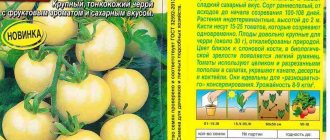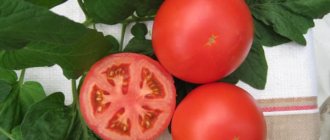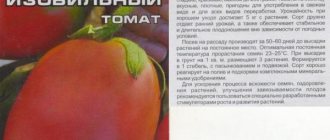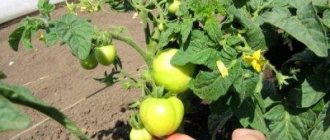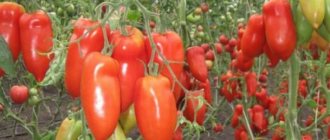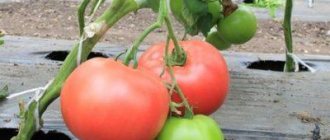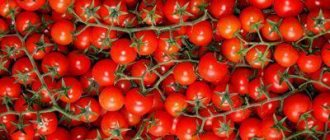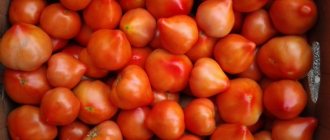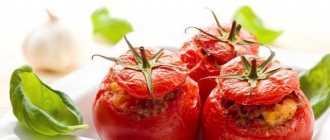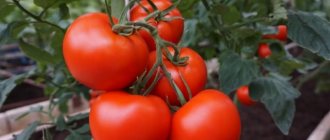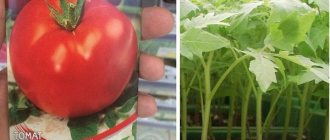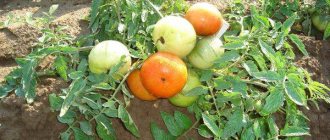Description of the variety
Description:
Fruit:
- Unusual shape, reminiscent of a strawberry;
- Bright red color;
- With a dense skin that is not prone to cracking;
- With sweet, juicy pulp;
- Number of seed chambers - 2;
- The dry matter content is high - approximately 7%;
- Small sizes. The average weight ranges from 25 to 40 grams.
Bushes:
- Determinant type;
- Medium height.
Height varies from 100 to 140 cm.
Characteristics and description
To choose the desired tomato varieties, any gardener carefully studies the characteristics and descriptions of many varieties, in order to then purchase the seeds he likes, germinate them, plant them on the plot, and then harvest the expected harvest.
The “Strawberry Cherry F1” tomato is endowed with outstanding qualities:
- determinant;
- early: tomatoes ripen 95-105 days from emergence;
- medium-sized: grows up to 1 m - 1.2 m, therefore, needs to be tied up;
- It is better to form a bush with 1-2 stems;
- tomatoes ripen on long clusters;
- 25 to 30 tomatoes grow on one bunch;
- the yield is not very high: you can collect 1-2 kg of fruits from a bush, but the taste of tomatoes compensates for their not very large quantity;
- characterized by abundant and friendly fruiting;
- is highly decorative.
The original fruits of this hybrid are impressive:
- These tomatoes are surprising - they are heart-shaped, reminiscent of strawberries;
- color bright red;
- the average fruit weight is 25-30 g, individual specimens can gain weight up to 40-45 g;
- two-chamber;
- high dry matter content - almost 7%;
- the pulp is very sweet (high sugar content), juicy;
- the skin is quite dense, practically does not crack;
- the taste is excellent.
Purpose: salad, for fresh consumption, because They are not stored for a long time; they are processed mainly for whole-fruit canning. But juices or pastes from Strawberry are unlikely to be obtained - the reason for this is the high content of dry substances. Tomatoes are an excellent treat for children and adults.
This wonderful hybrid was bred by Russian breeders, and in 2011 it was included in the State Register as a species that can be grown both indoors and outdoors. Tomato “Cherry Strawberry F1” - first generation hybrid; The originator is the agricultural company SeDek.
It is impossible to obtain seeds from the fruits of hybrid varieties, from which the same variety can then be grown.
Hybrids are obtained as a result of crossing different varieties, therefore anything can grow from the seeds of such fruits - as they say: “not a mouse, not a frog, but an unknown animal.”
It is also necessary to take into account that the hybrid “Strawberry Cherry F1” is best grown in open ground in warm regions of the country. In the northern regions it may freeze slightly and not produce a large harvest.
Tomatoes: advantages and disadvantages
The tomato hybrid “Cherry Strawberry” has the following advantages:
- Early ripening;
- Friendly return of fruits;
- Disease resistance;
- High taste characteristics;
- Unpretentiousness in care.
The disadvantages of the hybrid include:
- Relatively low yields;
- Poor keeping quality of fruits;
- Inability to use fruits for juice production.
Advantages of the variety
Gardeners who grow the variety speak well about tomatoes. Like all varieties, Strawberry Cherry has a number of advantages:
- Good yields are noted if the rules for cultivation and care are observed.
- Excellent decorative properties allow you to grow bushes to decorate your site.
- The taste of tomatoes is at the highest level.
- Strong immunity to pests and common diseases.
- Friendly simultaneous cultivation of tomatoes.
All these qualities allowed the variety to become popular among summer residents and gardeners. However, along with all the advantages, the variety has some disadvantages.
Growing tomatoes
The quantity and quality of the future harvest depend on properly grown seedlings. Therefore, this process should be treated with special attention.
How to prepare seeds?
Description:
- To disinfect seed material, use a pale pink manganese solution. The duration of the procedure is from 30 to 40 minutes;
- Then soak for 24 hours in clean water, which is replaced every 3-4 hours;
- At the end of the procedure, the seed material is slightly dried on a paper napkin.
Sowing seed material
Description:
- First, you should decide on the sowing time. It is better to sow seeds in late March-early April;
- The containers are filled with nutrient substrate, purchased or prepared independently;
- Seeds are sown in grooves 2 to 3 cm deep. After watering;
- The containers are covered with cling film and left in a warm room;
- Do not forget to regularly open the film to ventilate the plantings, as well as water them;
- With the emergence of seedlings, the shelter is completely removed, and the containers are placed on a sunny windowsill;
- In the phase of a pair of full leaves, tomato seedlings are planted in a separate container.
Rules for planting seedlings
Description:
- You can start planting in unprotected soil after setting a stable warm temperature at night, in soil heated to +16...+18 degrees. Planting in greenhouse structures is carried out earlier;
- When transplanting, take into account the recommended scheme - 70x30-40 cm;
- Directly during planting, a peg is installed near each plant for further tying.
This will avoid subsequent injury to the root system.
Features of growing the variety
In order for the Strawberry Cherry tomato to grow as a healthy and strong plant and then delight you with an excellent harvest of sweet, tasty fruits, it, even with all its undemandingness, needs to be grown correctly.
Seedling
Growing seedlings is a very important period in the growth process of a tomato:
- seeds can be sown in the third ten days of February (for central Russia);
- First soak the seeds in a pink solution of potassium permanganate for 30-40 minutes;
- then for a day - in clean water, which is changed every three to four hours;
- dry the seeds slightly (you can use a paper napkin);
- plant in boxes or other containers to a depth of no more than 1.5 cm, otherwise it will be difficult for the seeds to germinate;
- the distance between the seeds is about 2 cm;
- you need to sow the seeds by spreading them on moist soil, then sprinkle them with earth to the desired height;
- cover the containers with film, which is regularly opened slightly to prevent the formation of moss, mold, etc.;
As soon as small sprouts appear, remove the film and water carefully and carefully so as not to knock off the tender, weak sprouts.
Bush care
Next, you should not forget about care:
- The hybrid is watered moderately every day. As a result of infrequent watering, brown cracks appear. Excessive watering contributes to watery tomatoes;
- Feeding with mineral fertilizers is no less important. It is advisable to use complex mineral compositions enriched with phosphorus, potassium, selenium, cobalt, zinc and iron. Agricola or Kemira fertilizers are perfect. Feeding is carried out no more than once a week. During the formation of ovaries, ammonium nitrate and wood ash are added to the mineral complexes. When using fertilizers, it is necessary to control the appearance of plants. If there is excessive growth of green mass and a small number of fruits, it is worth reducing the number of fertilizing;
- The bush is usually grown with two stems, but one is also acceptable;
- Reliable supports are used to support the branches.
Characteristics and description of the Cherry Strawberry tomato variety, its yield
In the spring, gardeners begin the “hot season”; they need to have time not only to prepare the soil for growing crops, but also to choose varieties. Cherry Tomato Strawberry F1 will pleasantly surprise those who are looking for their ideal tomato variety.
Description of the Cherry Strawberry variety
The world's first cherry tomatoes were brought out by breeders from Israel about 80 years ago. Since then, cherry tomatoes have become one of the most popular vegetables in the world. Today, a huge number of different varieties have been bred.
In order not to make a bad choice, you need to study the description of the variety in detail.
The Cherry Strawberry tomato was bred by breeders from Russia. In 2011, the hybrid received state registration as a variety intended for planting in open and closed ground.
F1 tomato belongs to the first generation hybrids. The originator is the agricultural company Sedek.
The plant is determinate, the growth of the bush is limited and does not exceed 1 - 1.3 meters in height. Bushes need to be tied up and shaped.
Tomatoes can be grown in the garden in beds, greenhouses and greenhouse shelters. It is rarely exposed to diseases that most often affect nightshade crops.
It is better to grow a hybrid in a vegetable garden in the southern regions of Russia. Since Cherry Strawberry is an early ripening plant, in northern latitudes the bushes may die during sharp frosts.
Fruit characteristics
The general characteristics of the Cherry Strawberry F1 tomato fruit are very important. As the name suggests, tomatoes are similar in appearance to strawberries. The shape of the fruit is unusual for tomatoes, heart-shaped. Fruiting is abundant.
A variety with early fruit ripening. You can harvest the crop within 100–105 days after the seedlings emerge.
One cyst can form from 10 to 20 fetuses. Under ideal conditions for growing seedlings, a cyst can contain up to 30 tomatoes. Cherry tomatoes are small, the weight of one fruit is no more than 25-35 grams. The pulp is sweet, juicy, with a high sugar content. The skin is dense and does not crack. The color of the tomatoes is bright red.
When growing 4 bushes per 1 sq. m. you can harvest up to 9 kg of crop.
Ripe tomatoes store very poorly. Therefore, immediately after harvesting, they must either be processed or consumed fresh. The disadvantage of this variety is that the fruits cannot be used for making tomato pastes and juices. Because they have a high dry matter content.
Those gardeners and vegetable gardeners who planted the variety on their plots were satisfied with the results. In addition to the high taste of the fruit, the Cherry Strawberry hybrid has a very attractive appearance. It’s impossible to take your eyes off the bushes strewn with bright red tomatoes.
Advantages and disadvantages of the variety
Reviews of the Cherry Strawberry F1 tomato from those farmers who planted the hybrid, as mentioned earlier, are mostly positive. Despite the fact that the hybrid has many advantages, it has a number of disadvantages.
- Gives a good harvest throughout the season;
- Very tasty fruits;
- The hybrid is not demanding in care;
- Good decorative qualities;
- Immunity to diseases of nightshade crops;
- Harmonious ripening of tomatoes.
- The variety is not high-yielding;
- The fruits do not differ in shelf life;
- Not suitable for preparing tomato juices and pastes;
- Bushes need to be tied up;
- It is necessary to form bushes;
- Seedlings can only be grown in open ground in the southern regions of Russia. In northern latitudes, it is recommended to use greenhouses and greenhouse shelters.
How to grow Cherry Strawberry correctly
The process of growing seedlings is the most important stage in gardening. To get a rich harvest, you need to pay special attention to it. The process of growing cherry tomatoes is practically no different from planting regular tomatoes.
First of all, it is important to know exactly the timing of sowing seeds. For Cherry Strawberry tomatoes, this is the beginning of April. Seedlings should be planted in open ground when the temperature remains above zero at night. The soil should warm up to +16 – +18 degrees.
I planted seeds for seedlings in this way:
- Pour soil into containers (you can buy a ready-made mixture in the store);
- Make furrows to a depth of 2 - 3 cm and plant planting material, water;
- Cover the boxes with cling film and take them to a warm place;
- Regularly remove the film and water the seeds;
- After the shoots appear, the film is removed and the boxes are placed in the sun.
When full-fledged leaves appear on the seedlings, it must be pruned. Cherry tomatoes do not like crowding and may not grow well. If the spring turns out to be cold and the bushes “sit” in the container for a long time when picking, the stem can be buried.
Farmers who have planted tomatoes of this variety know that its distinctive feature is the need to form bushes into one or two stems.
Features of care
It is important to remember that the hybrid of this variety loves daily moderate watering. If watering is infrequent, brown cracks will appear on the fruits. If you water frequently, the tomatoes will be too watery.
Mineral supplements are also important. It is best to use complex fertilizers for this purpose. Fertilizers should contain substances such as phosphorus, potassium, selenium, cobalt, zinc and iron. You can use Agricola or Kemira fertilizers.
You need to feed the bushes no more than once a week, after the seedlings are planted in the ground. During the formation of ovaries, ammonium nitrate and wood ash can be added to mineral fertilizers.
When applying fertilizers, you need to pay attention to the appearance of the plants. If they begin to increase leaf mass, and the fruits become less and less, it means that the plants are overfed.
Diseases and pests
Main diseases and pests:
- Most often, the hybrid is affected by brown spotting. Tomatoes are susceptible to the disease both in greenhouses and in unprotected soil, especially when growing in the southern regions. The drug “Zaslon” is used to treat plants. They also reduce the level of humidity in the air and soil through ventilation and reducing the amount of watering;
- The hybrid can also develop powdery mildew. The drug “Profi Gold” is effective against it;
- The most common pest is the Colorado potato beetle, which causes significant damage to the crop. Insects are collected manually, then the bushes are treated with the drug “Prestige”;
- Loosening the soil, followed by sprinkling pepper and ground mustard, at a ratio of one teaspoon per 1 m2, is effective against slugs;
- The nightshade miner is successfully combated using the drug “Zubr”.
Productivity
If all care recommendations are followed, taking into account planting no more than 4 bushes, a harvest of 7 to 9 kg will be harvested from 1 m2 of plantings. The low level of yield is more than compensated by the excellent taste of the fruit.
Which regions are best to grow in?
The Cherry Strawberry hybrid is optimal for growing in the southern regions in unprotected soil. In regions with colder climatic conditions, it is advisable to cultivate in greenhouses or under film covers.
Reviews about the variety from those who planted
Since its appearance, the Cherry Strawberry tomato has been loved by gardeners because of its taste and decorative appearance. Gardeners who had already grown the hybrid were completely satisfied with the result. By growing Cherry Strawberry you can not only get a tomato harvest, but also decorate your garden plot.
The hybrid tomato "Cherry Strawberry" is easy to care for, so it will be an excellent option for beginners in gardening. With a minimum of effort and time, you can get a pretty good harvest of quality tomatoes.
Review from a gardener:
Subtleties of caring for cherry tomatoes
The small size of the fruit affected exclusively the size of the seeds. The technology of seed treatment at the stage preceding sowing reproduces the procedure carried out with traditional tomatoes. A similar approach is applied during the period of growing seedlings.
At the same time, it is necessary to take into account that plants growing in open ground and in greenhouses require staking and shaping. When forming bushes of tall crops, they are limited to 1-2 stems.
For determinant samples, the indicator is limited to the number 2. The growth point is transferred to the stepson moving to the side. The need for garter is explained by the significant weight of the brushes, some of which fall to the ground.
At the stage of washing soil-contaminated fruits, the possibility of damage to the skin that protects the pulp cannot be ruled out.
Cherries have earned the nickname of miniature sissies. The negligence shown by the gardener is fraught with the formation of cracks in the fruits. Uniform watering helps prevent such a disaster.
Another nuance is associated with the stage of harvesting cherry tomatoes. Only ripened fruits should be removed from the bush. Only with this approach will you be able to fully enjoy the taste of small tomatoes.
Attempts to grow tall varieties on balconies and loggias failed. Such tomatoes are not able to reveal their inherent potential even in containers of 6-10 liters. Often, high-quality regular feeding is not able to correct the situation.
Buckets are suitable for medium-sized varieties (with bushes whose height does not exceed 70 cm). However, they are unlikely to get along on window sills.
For the purposes of hanging cultivation, the Talisman variety, bred by amateurs, is ideal.
Cherry tomatoes announced for growing in greenhouses can also grow in open areas of soil.
In the latter case, it is recommended to grow them as a trellis crop. Specimens planted in greenhouses require timely removal of stepsons due to their tendency to thicken.
